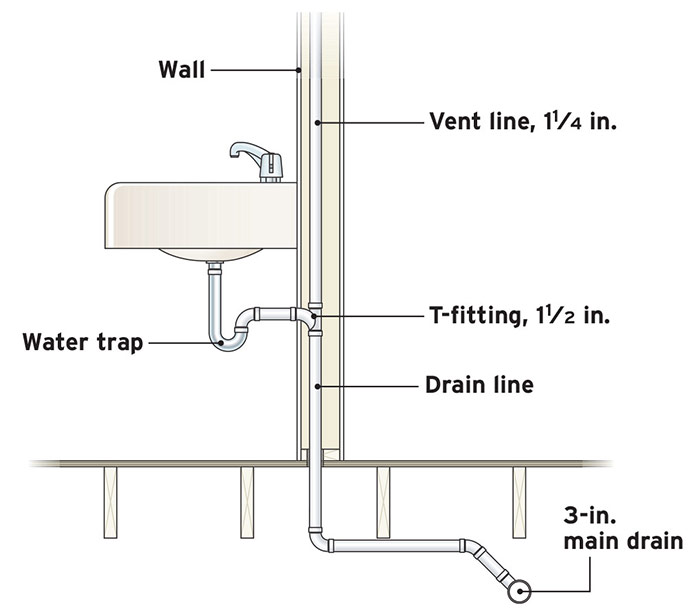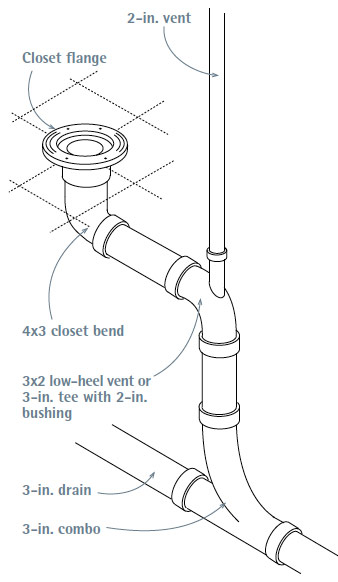The Benefits of Proper Ventilation in Your Plumbing System
The Benefits of Proper Ventilation in Your Plumbing System
Blog Article
In this article underneath you might get some sound resources around What Are Plumbing Vents and Why Are They Important?.

Proper ventilation in pipes systems is frequently ignored, yet it is vital for preserving the performance and safety of your home's plumbing. Ventilation aids regulate air pressure, prevent the buildup of harmful gases, and guarantee the reliable removal of waste. In this overview, we will certainly check out the value of correct plumbing air flow, exactly how it works, and the benefits it brings to your plumbing system.
Understanding Ventilation in Plumbing
Air flow in plumbing describes the network of pipes that allow air to stream with the drainage system. These vents serve several purposes, consisting of regulating atmospheric pressure within the pipelines, preventing sewer gases from going into the home, and helping in the smooth flow of wastewater.
Exactly How Air Flow Functions in Pipes Solutions
Air Pressure Policy
Proper ventilation keeps well balanced atmospheric pressure within the plumbing system. When water streams through pipes, it displaces air. Without appropriate air flow, this variation can produce adverse stress, bring about slow drains or siphoning of water from catches, which can create undesirable odors to leak right into the home.
Stopping Drain Gas Buildup
Among the most important functions of plumbing vents is to prevent drain gases, such as methane and hydrogen sulfide, from collecting within the home. These gases can pose significant wellness threats and are highly combustible. Vent pipelines enable these gases to get away safely outdoors.
Aiding in Waste Elimination
Air flow assists in the effective removal of wastewater by preventing airlocks in the drain system. When air can flow easily via the vents, it allows water and waste to stream efficiently with the pipes, decreasing the threat of obstructions and back-ups.
Sorts Of Pipes Vents
Key Heap Vent
The main pile air vent, also referred to as the air vent pile, is the primary vent in a plumbing system. It extends from the primary drainpipe line up via the roofing, allowing gases to get away and fresh air to go into the system.
Branch Vent
Branch vents link to the major pile vent and serve private components, such as sinks, commodes, and showers. These vents guarantee that each fixture has adequate air flow to operate properly.
Air Admittance Valve (AAV).
An Air Admittance Valve (AAV) is a one-way valve that permits air to enter the plumbing system without the requirement for a standard vent pipe prolonging through the roof covering. AAVs are generally used in remodellings or areas where installing a conventional vent is impractical.
Indicators of Poor Air Flow in Pipes.
Slow Draining Fixtures.
If your sinks, tubs, or toilets are draining pipes gradually, it could be an indication of poor ventilation. Inadequate air circulation can develop a vacuum effect, making it challenging for water to drain properly.
Gurgling Sounds.
Gurgling sounds coming from drains are commonly an outcome of air being drawn through water traps because of unfavorable stress in the pipes. This is a clear indication of not enough ventilation.
Unpleasant Odors.
Drain smells inside your home are a warning that your pipes system is not properly aerated. This can imply that sewer gases are not being adequately aired vent outside, resulting in potentially harmful problems.
Common Air Flow Mistakes.
Poor Vent Sizing.
Utilizing small air vent pipelines can lead to poor air flow and stress imbalances in the system. It's important to utilize vents that satisfy the certain needs of your plumbing system.
Improper Vent Placement.
Placing vents as well far from the components they serve can lower their efficiency. Appropriate positioning makes certain that air can flow openly and successfully through the system.
Disregarding Code Requirements.
Building regulations provide details standards for pipes air flow. Neglecting these codes can lead to a system that falls short to function properly and might bring about costly repair work or health hazards.
Advantages of Proper Ventilation.
Boosted System Performance.
Properly aerated plumbing systems run more successfully, with fewer clogs, faster draining pipes, and less strain on the pipes. This performance prolongs the lifespan of the plumbing system.
Improved Air High Quality.
By preventing sewer gases from entering your home, proper air flow contributes to better interior air quality, making your living setting healthier and more comfy.
Stopping Water Damages.
Sufficient ventilation assists prevent water from being siphoned out of traps, which can bring about sewer gases entering the home and triggering water damage with time.
Steps to Guarantee Correct Air Flow.
Consulting Plumbing Codes.
Constantly get in touch with local plumbing codes when making or changing your pipes system. These codes supply the necessary guidelines for correct airing vent and guarantee your system meets safety and security criteria.
Routine Assessment and Maintenance.
Routine inspections can aid recognize potential ventilation problems before they end up being significant problems. Maintenance tasks, such as cleaning vent pipes and looking for clogs, are vital for maintaining the system in good working order.
Professional Installation.
For brand-new setups or major modifications, it's wise to employ an expert plumbing professional. They have the experience to make certain the air flow system is appropriately developed and set up according to code.
Verdict.
Correct air flow is a vital part of any kind of pipes system, ensuring that it operates efficiently and safely. By comprehending the significance of air flow, acknowledging the indicators of inadequate air flow, and taking steps to keep your system, you can prevent costly concerns and protect your home's air high quality.
4 Things You Should Know About Your Plumbing Vents
What Plumbing Vents Are
Also called a vent stack, a plumbing vent is a vertical pipe attached to your drain line that runs through your roof. The plumbing vent pipe, or plumbing air vent, removes gas and odors from your plumbing system and allows fresh air to enter the pipes, helping the water to flow out of the drain pipes.
What Plumbing Vents Do
Plumbing vents have two basic functions. One of which is to allow unpleasant smelling wastewater and sewer gasses to escape your plumbing system instead of entering your home. Plumbing vent pipes are typically located on roofs, away from windows, to ensure the fumes exit the home completely.
The other function of the plumbing vent is to move fresh air into your plumbing system. This helps move water through every plumbing fixture in your house, like toilets and sink drains. Think of the way in which you need to let a little air into the bottle as you pour soda in order to make the drink flow smoothly.
Different Types of Plumbing Vents
True vent: This is the most common vent option. In simplest terms, a true vent is a vertical pipe attached to your drain line that exits through the roof. They often function as the main vent that other fixtures can connect to. Re-vent pipe or auxiliary vent: Attached to the drain line near specific plumbing fixtures, re-vent pipes run up and over to connect to the main vent. Common vent: Two plumbing fixtures installed on opposite sides of a wall are typically tied into the vent stack using something known as a sanitary cross. Wet vent: This venting option operates as a drain pipe and a vent at the same time. Wet vent drainage systems drain water from one fixture while venting the air from another. Although they’ve been used for over 100 years, wet vent systems have only recently been added to the plumbing code in many areas. If you’re planning on installing one in a bathroom remodel, make sure you check your local code prior to construction. Loop vent: For free-standing fixtures like kitchen island sinks, loop vents are ideal. These vent pipes run under the floor, rise from the P-trap, and create a loop inside the cabinet sink. Air admittance valve: An AAV is a one-way mechanical valve typically installed at the site of the plumbing fixture. AAVs allow venting to occur without having to tie into a larger venting system. They’re ideal for venting fixtures where you aren’t able to easily connect to an existing vent system. Common Plumbing Vent Issues
Although vent pipes typically don’t have water flowing through them, they’re still subject to many typical plumbing issues. For example, clogs are one of the most common problems associated with sewer vent pipes. If your vent pipe gets clogged, all of your plumbing fixtures tied into the vent stack will be affected.
A sink with a slow drain that bubbles and gurgles or a strong sewage smell around your toilet are both indicators that your toilet vent pipe is clogged. Because most vent pipes exit through the roof, old leaves, twigs or even a bird’s nest could be clogging the pipe.
Clogs in your vent pipe system cause a buildup of negative pressure, meaning that water won’t be able to flow out of your home very well. It’s similar to putting your finger over the opening of a straw to trap water inside. When you remove your finger, the water is able to flow out of the straw.
If you suspect you have any blockage in your vent, make sure you have a professional come examine the situation. Left unchecked, a blocked air vent can lead to other costly repairs, like leaks and sediment buildup.
Under Pressure
Pipe vents are essential aspects of a home’s plumbing system. Owning a home means learning about all sorts of things you never put much thought into before. But by understanding as much as you can about the important systems of your home, you can keep those budgets intact and those anxiety levels low.
https://www.homeserve.com/en-us/blog/home-improvement/plumbing-vents/

I recently found that write up on Essential Plumbing Vent Pipes: Understanding Their Role when doing research the internet. Sharing is nice. Helping others is fun. Thank-you for going through it.
Request An Estimate Report this page